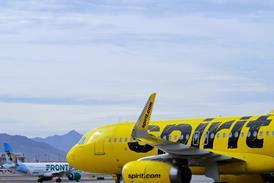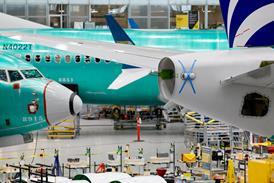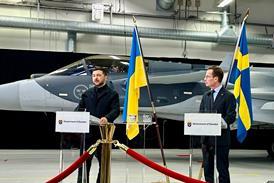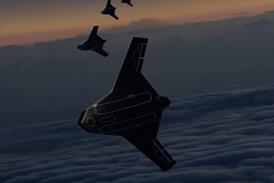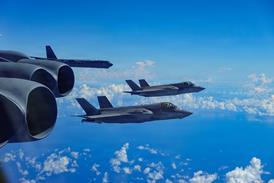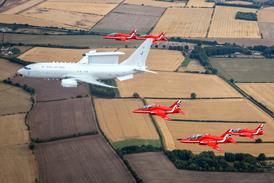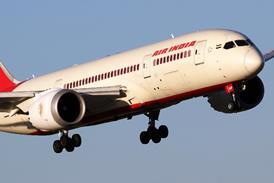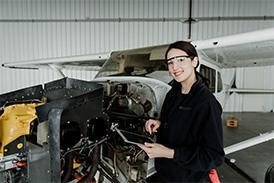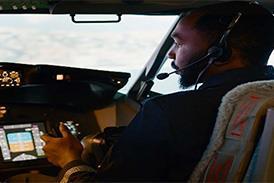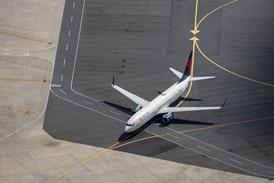Autonomy start-up Shield AI is expanding its tactical portfolio to include jet-powered aircraft.
The San Diego-headquartered firm on 22 October revealed a new vertical take-off and landing (VTOL)-capable fighter platform called X-BAT, which will offer a range beyond 2,000nm (3,700km) and operate at altitudes of 50,000ft without any pilot input.
A promotional concept video shared by Shield AI indicates the X-BAT will use a tailless blended-wing-body fuselage with internal weapons bays, a single jet engine and air intakes embedded in the nose section. Renderings indicate that larger munitions like the Raytheon AIM-174B long-range air-to-air missile could be carried externally.
The cranked-kite outer mould shape is reminiscent of the experimental Northrop Grumman X-47B uncrewed jet tested by the US Navy. Shield AI lists the X-BAT’s wingspan as 11.9m (39ft), with a length of 7.9m.
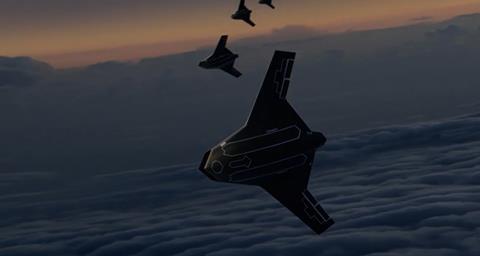
Perhaps the most interesting aspect is the launch and recovery system Shield AI has planned for the X-BAT.
Unlike the autonomous fighters being developed for the US Air Force’s (USAF’s) Collaborative Combat Aircraft (CCA) programme, which feature conventional wheeled landing gear, Shield AI is pursuing a runway independent configuration for the X-BAT.
A concept video depicts an X-BAT jet mounted onto a wheeled launch trailer, with its wings folded. The wings unfold and a rail system orients the aircraft into a vertical orientation, from which it accelerates using only the internal jet engine, eventually rotating into horizontal flight.
The Kratos XQ-58A Valkyrie uncrewed jet takes off in a related manner, using external rocket boosters to launch from an inclined rail system for runway independent flight.
However, unlike the XQ-58A, Shield AI’s jet will apparently not employ a parachute to land. The company’s concept video shows the X-BAT landing vertically on one of the rail launch trailers, with its engine oriented downward in a way reminiscent of a SpaceX rocket returning to Earth.
Shield AI has not yet revealed what engine will propel the X-BAT, saying only that the jet is being “designed around a proven fighter-class powertrain to ensure reliability, maintainability, and logistics maturity”.
The company does, however, confirm that the engine will include thrust vectoring capability.
Footage provided to FlightGlobal by Shield AI shows what the company says is the X-BAT engine undergoing static testing on an outdoor stand. The powerplant appears to be a turbofan engine that resembles a Pratt & Whitney F100 or GE Aerospace F110.
Shield AI suggests that the X-BAT will be capable of launching both from land and ships at sea, with three of the jets and their launch rails fitting in the footprint of a single conventional fighter aircraft.
“X-BAT is a revolution in air power because it combines four things: VTOL, range, multi-role capability, and autonomy,” says Armor Harris, senior vice-president of aircraft at Shield AI.
“VTOL plus range solves survivability on the ground and dependency on tankers [and] multi-role provides critical flexibility as the threat evolves,” he adds.
Shield AI tells FlightGlobal that the new aircraft has been in development for the past 18 months. VTOL demonstrations are planned for as soon as autumn 2026, with all-up flight testing and operational validation following in 2028.
The move into larger jet aircraft is a significant thrust for Shield AI, which is best known for its autonomy software.
The company’s Hivemind system is the brain that powers numerous uncrewed aerial systems, including the modified Lockheed Martin F-16D used by the US Defense Advanced Research Projects Agency (DARPA) to conduct autonomous dogfighting experiments in 2024.
Those experiments saw Hivemind take control of the X-62A VISTA to engage in within-visual-range combat – better known as dogfighting or turn fighting – against a human pilot in another F-16.
Hivemind will also power the X-BAT.
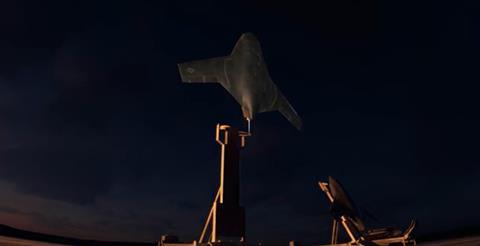
Shield AI has also seen success with smaller uncrewed aerial systems (UAS), such as the company’s tail-sitting V-BAT, which can launch and land vertically from the shipboard flight decks. The type is in use by both the US Navy and US Coast Guard.
Company co-founder Brandon Tseng says Shield AI’s goal is to “prove the value of autonomy… and re-imagine air power”.
“X-BAT represents the next part of that plan, expanding US and allied war fighting capacity through a transformative, runway-independent aircraft,” Tseng adds.
He further describes airpower without runways as the “holy grail of deterrence”.
Such runway independence has become a focus of numerous US military procurement efforts, including the US Army’s next generation of reconnaissance UAS platforms, ship-to-shore logistics for the US Marine Corps and an experimental troop transport being built by rotorcraft manufacturer Bell for DARPA.
Whether Shield AI will find a buyer for its unique concept remains to be seen.
Despite the benefits of runway independence, the USAF has opted for a conventional take-off and landing (CTOL) approach for its first generation of FQ-series uncrewed fighters.
Kratos, which was an early leader in the uncrewed fighter race, appears to be moving in the opposite direction, now developing a wheeled landing gear option for the XQ-58A.
General Atomics Aeronautical Systems, another long-time leader in the uncrewed aircraft and autonomous jet space, also uses CTOL or short take-off and landing on its current designs and prototype concepts, including the YFQ-42A, which is competing in the USAF’s CCA effort against Anduril Industries’ YFQ-44A design.


